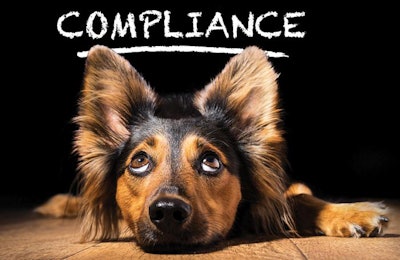
U.S. pet food inspections conducted for compliance with Food Safety Modernization Act (FSMA) regulations in the Food and Drug Administration’s (FDA) fiscal year (FY) 2021 yielded 89 citations for violations, and hazard analysis—failure to identify or implement this safety component—topped the list at 12 citations. Preventive controls (PC) violations came in second at eight, followed by lack of a food safety plan at five, then pest control and corrective action citations at four each.
The inspection data was provided via a video presentation by Dave Edwards, Ph.D., director of the division of animal feeds for FDA’s Center for Veterinary Medicine, during the American Feed Industry Association’s 2022 Pet Food Conference, held January 25 at the International Production and Processing Expo in Atlanta, Georgia, USA.
Inspections down during COVID, common violations
In contrast to the pet food numbers, animal feed inspections drew 135 total citations, also led by hazard analysis (17), PC (13) and lack of a food safety plan (eight), but plant maintenance (seven), corrective action and environmental monitoring (five each) also made that list.
Edwards did not share historical data of animal feed and pet food inspection citations for comparison, but his data did provide context for the 2021 numbers, as the COVID-19 pandemic caused FDA to dramatically decrease its number of FSMA inspections during FY 2020 and 2021. From FY 2019 highs of about 950 animal feed and pet food inspections conducted for compliance to current good manufacturing practices (CGMP) regulations and nearly 250 for PC regulations, the number of inspections fell to about 750 CGMP and 150 PC inspections in FY 2020, then to about 300 CGMP and 140 PC in FY 2021.
Edwards added that in FY 2021, most animal feed and pet food inspections were conducted by state regulatory partners, rather than FDA inspectors.
FDA: Pet food recalls call for good lot code practices
While providing only a few specific data, Edwards said the top pet food recall causes over the past few years have been pathogens, aflatoxin (especially in 2020 and 2021) and vitamin D levels; he noted that the latter problem had led to six recalls in 2019 and four in 2021.
In relation to recalls, Edwards emphasized the importance of product lot codes. Though there are no regulatory requirements for them, he said, pet food manufacturers should follow good business practices. Lot codes can:
- Make it easier to track and report if a problem occurs, aiding both the manufacturer and FDA;
- Help limit the scope of a recall, due to faster and more efficient tracking;
- Conversely, if a lot code is not well applied—e.g., used for a long time for month after month—it can result in a larger recall.

















